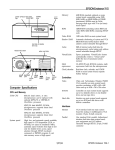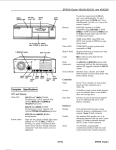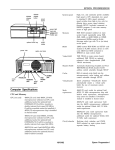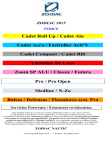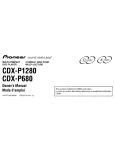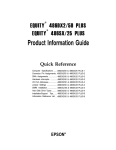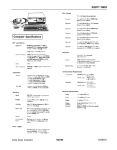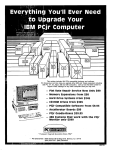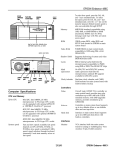Download Epson Progression 4 Specifications
Transcript
EPSON Progression 4 power (SPEED) light diskette drive hard disk access light power button Memory 4MB RAM standard soldered on main system board; expandable using 1MB, 4MB, 16MB, or 64MB SIMMs to 128MB (maximum); SIMMs must be 36bit, fast-page mode type with 70 ns (or faster) access speed ROM 128KB ROM containing system BIOS and video BIOS; 64KB ROM containing SETUP code Video RAM 1MB video RAM on main system board Shadow RAM Automatic shadowing of system and VGA BIOS ROM into RAM; shadow RAM address control selectable through SETUP Cache 8KB of internal cache (built into the microprocessor); cache testing and address control selectable through SETUP Virtual Cache Epson proprietary VirtualCache™ feature automatically creates a “virtual cache” buffer the size of maximum system memory Math coprocessor On 4DX2/50 and 4DX2/66 systems, math coprocessor built into the microprocessor Clock/calendar Real-time clock, calendar, and CMOS RAM on main system board; separate battery backup bay for hard disk, diskette, tape, CD-ROM, or other drive 115/230 VAC switch . powei keyboard inlet port I mouse pod option card slots drtal port1 selial pofl2 VGA \ monitor paral’d port pod Controllers Video Chips and Technologies Wingine™ P64200 VGA controller on main system board; provides resolutions of 800 x 600 x 64K colors and up to 1024 x 768 x 256 colors Diskette 4SX/33: Intel® i486SX, 33 MHz microprocessor; can be replaced with optional 487SX/33 or ODP486-33 OverDrive™ processor Controller on main system board supports up to two diskette drives or one diskette drive and one tape drive Hard disk Interface on main system board supports up to two IDE hard disk drives with built-in controllers 4DX2/50: Intel i486DX2, 50 MHz microprocessor; supports future Intel OverDrive processor Interfaces Computer Specifications CPU and Memory 32-bit CPU 4DX2/66: Intel i486DX2, 66 MHz microprocessor; supports future Intel OverDrive processor System speed Monitor VGA interface built into main system board for analog or multifrequency VGA monitor; 15-pin, D-shell connector Parallel One standard 8-bit parallel, bidirectional interface built into main system board; port assignment and I/O address selectable through SETUP; 25-pin, D-shell connector High, low, and automatic speeds available; high speed is CPU-dependent (33, 50, or 66 MHz), low speed is simulated 8 MHz, automatic speed switches from high to low only for diskette drive access; speed selection through SETUP, keyboard command, or ESPEED program; 0 wait state memory access at high speed 7/27/93 EPSON Progression 4-1 EPSON Progression 4 Serial Two RS-232C, programmable, asynchronous interfaces built into main system board; port assignment and I/O addresses selectable through SETUP; 9-pin, D-shell connectors Keyboard PS/2 compatible keyboard interface built into main system board; keyboard speed, delay, and num lock settings selectable through SETUP; 6-pin, mini DIN connector Type Input ranges Mouse PS/2 compatible mouse interface built into main system board; 6-pin, mini DIN connector Maximum outputs Option slots Four standard 16-bit (or 8-bit) I/O expansion slots; ISA compatible; 8 MHz bus speed +5 VDC at 18 Amps, +12 VDC at 4.0 Amps, -5 VDC at 0.3 Amps, -12 VDC at 0.3 Amps Frequency 47 to 63Hz Cables Two to main system board; four to mass storage devices Speaker Internal; operation controllable through SETUP and volume selectable by software Alternate VGA IBM compatible VGA pass-through interface built into main system board; 26-pin connector Mass Storage Horizontal mounts Three drives maximum (two horizontal mounts and one vertical mount), configurable using the following: Up to two externally-accessible, half-height horizontal mounts; each horizontal bay can accommodate one s&inch form factor diskette, tape, CD-ROM, or other drive, or one 3M-inch form factor hard disk, diskette, tape, CD-ROM, or other drive with 5X-&h mounting frames attached Vertical mount One internal third- or half-height vertical mount; vertical bay can accommodate one 3%inch form factor hard disk or other drive Diskette drives 5.25-inch, 1.2MB (high-density) 3.5 inch, 1.44MB (high-density) 3!4-inch form factor hard disk drive(s), up to half-height size; the first mounted vertically, second mounted horizontally Hard disk drives Other devices Power Supply 145 Watt, fan-cooled 90 to 132 VAC and 180 to 264 VAC, switch selectable voltage Option Slot Power Limits Maximum current +5 volts +12 volts For each slot For all four slots 7 Amps 16 Amps 1.5 Amps 0.3 Amps 3 Amps 0.3 Amps -5 Volts and -12 Volts Environmental Requirements Condition Operatlng range Temperature 41’ to 95’ F (5O to 35OC) 20% to 60% Humidity (noncondensing) -3OOto9,QOOR (-100 to 3,000 m) M a x i m u m 66’F &O°Cl wet bulb Acoustical 37.4 dB(A) noise At&l& Physical Characteristics Width 14.8 inches (370 mm) Depth Height 16.5 inches (412 mm) 4.8 inches (120 mm) weight 16.7 lb (7.6 kg), without keyboard Half-height tape drive, CD-ROM drive, or other storage device; 51/4-&h form factor or 3%inch form factor with 5%inch mounting frames attached EPSON Progression 4-2 Detachable; two-position height; 101 sculpted keys; numeric/cursor control keypad; four-key cursor control keypad; 12 function keys Keyboard 7/27/93 EPSON Progression 4 Extended VGA Modes Major Subassemblies Mode 60 61 62 64 65 6A/70 16 main system board 170Hz J1 5-JQ option board riser card I \ power supply ‘” 72 1024x766 16 79 640 x 480 256 7c 800x600 256 60 Hz 70 Hz 72 Hz 75 Hz 60 Hz 73 Hz 56 Hz 60 Hz NI NI --. NI = Non-interlaced I = Interlaced Wingine Modes Mode 30 Size 640x480 Colors 256 32 800x600 256 34 1024x766 36 40 1024x766 640 x 480 41 640 x 480 42 800x600 43 800x600 256 Refresh rate 60 Hz 73 Hz 56 Hz 72 Hz 60 Hz 70 Hz 72 Hz Mode type NI NI processor diskette drive \ speaker NI horizontal drive bays -4 NI NI NI I NI I NI = Non-interlaced I = Interlaced 5/3/93 EPSON Progression 4-3 EPSON Progression 4 Main System Board Diagram VGA video parallel serial 2 - 31 l P I nl I n I n u9e u109 l-l I 0 0 u91 103 108 u97 n E UE mouse keyboard , , u w alternate VGA feature connector serial 1 131 El Uil 102 E u l UIO 0 I7 u99 u12 100 l E option board - riser card connedor LL l 0 u13 0 u90 r - l c U99 FDD - connector UlS l 0 Ul6 ! u9 0 n Uli ml q u75 u53 u37 u77 US3 UBO 17 ml ml 0 ue1 us5 US1 UBO u54 0 a n ul U76 u79 u57 U63 17 US8 ul u79 u59 m-l L13 0 us2 u54 0 -u &16C&5&C~J2c@L~ %! SIMM2 SIMM1 EPSON Progression 4-4 5/3/93 Lll 0 HDD connector EPSON Progression 4 VGA Port Connector (CN2) Connector Pin Assignments Parallel Port Connector (CN5) pin 5 pin 1 pin 1 I pin 10 pin 6 ~oooooooo~oo~ pin 15 pin 11 pin 13 I VGA Port Connector Pin Assignments pin 25 pin 14 Parallel Port Connector Pin Assignments Pin 1 Signal Strobe 1 Data 0 2 Data 1 3 Data 2 4 Data 3 5 6 Data 4 7 Data 5 Data 6 0 Data 7 9 *Active bw logic 1 Pin 1 Signal 10 11 12 13 14 15 16 17 18 1 Pin 1 Signal ACK’ Busy PE Sd%t Auto’ Error* hit* Select in’ Signal ground 19 20 21 22 23 24 25 Signal ground Signal ground Signal ground Signal ground Signal ground Signal ground Signal ground pin 25 pin 1 “Y...........Y~’ ,/ooooooooeoooow. pin 2 ’ ’ pin 26 Serial Port Connectors (CN4 and CN8) pin 1 VGA Feature Connector (CN17) VGA Feature Connector Pin Assignments pin 5 pine- pin9 Serial Port Connector Pin Assignments Pin 1 Signal Data carrier deted Pin 6 Signal Data set ready 2 3 4 5 Receive data Transmif data Data terminal ready Not used 7 a 9 Request to send Clear to send Ring indicator Keyboard Connector (CNlO) and Mouse Connector (CN9) pin 6 ‘Active bw logic DMA Assignments pin 5 pin4w pin3 pin 1 pin 2 Caution Although the keyboard and mouse connectors are physically identical, they cannot be used interchangeably. Keyboard and Mouse Connector Pin Assignments Pin I Signal 1 Data 11 2 I Reserved 3 I Ground I Pin I Signal 14 5 6 1 +5 VDC (fused) Clock Reserved 5/3/93 EPSON Progression 4-5 EPSON Progression 4 Hex address* EE2 - EE3 Hardware Interrupts A! Data acquisition (adapter 3) . .- - - r .-. 1) luster (adapter 4) j GPIB (adapter 5) 1 GPIB (adapter 8) 1 WING INEIRAMDAC 1 A2El C2El WC8 , ~1 * Recommended addresses for installing devices System I/O Address Map Hex address* 000-OlF 020 - 021 Assigned device DMA controller 1, 8237A-5 Interrupt controller 1, 8259A, master Epson resewed function Timer, 8254-2 040-043 8042 (Keyboard and mouse) 080-081,084 070 - 071 (CMOS) Real-time clock NMI (non-maskable interrupt mask) 080-08F DMA page register, 74LS812 OAO - OAl Interrupt controller 2, 8259A OCO-ODF DMA controller 2,8237A-5 OF0 Clear math coprocessor busy Reset math coorocessor OF1 OF8 - OFF Math coprocessor lFO- lF8 Hard disk drive Game IK) 200 - 207 1278 - 27A I Parallel printer port 3 Alternate enhanced graphics adapter 280 - 2DF 2El GPIB (adapter 0) 2E2 and 2E3 Data acquisition (adapter 0) Serial port 2 2F8 - 2FF 300-31F Prototype card 348 - 357 DCA 3278 i 022 - 024 Jumper Settings See the illustration on page 3 for the location of the jumpers on the main system board. CPU Speed Jumper Settings 55 CPU type* 486sw33 J8 57 58 Other Jumper Settings I JumDer number J9” I Jumper setting A* B A* B A’ B A B’ EPSON Progression 4-6 J4* A A B B B B A A A A ODP48833 or 487SW33 B A B A ODP488DX50/88 * Factory-set according to system type. You need to change jumpers J5-J8 only if you have the 4Sw33 system and you remove the original microprocessor chip and install a new one, or if you install a future OverDrive processor in the 4DX2/50 or 4DX2/88. J12” Enhanced graphics adapter Color/graphics monitor adapter Floppy disk drive controller Serial port 1 Data acquisition (adapter 1) Cluster (adapter 1) Data acquisition (adapter 2) Cluster (adapter 2) J3* B A CPU Type Jumper Settings Jll 3D0 - 3DF 3F0 - 3F7 3F8 - 3FF 8E2 and 8E3 790 - 793 AE2 and AE3 B90 - 893 J2* A B * Factory setting according to processor external speed clock; do not change these jumpers unless you replace the DX2/50 chip with a DX2/88 chip. JlO 3C0 - 3CF Jl* A B CPU speed SX/33, DX2/66 (33 MHz) DX2&0 (25 MHz) J13 1 Function Enables the built-in mouse connector Disables the built-in mouse connector Enables the built-in VGA display adapter Disables the built-in VGA display adapter A color monitor is installed A monochrome monitor is installed Enables a mouse or other pointing device connected to an option card Disables a mouse or other pointing device connected to an option card Disables the password Enables the password Reserved A B’ J14, J15 A’: lB * Factory setting “To use a mouse connected to a port on an option card, set J9 to B and J12 to A. lf you connect another type of pointing device (such as a joy stick) to the option card port, set both jumpers to A. 5/3/93 EPSON Progression 4 Processor Chips Hard Disk Drive Types If you have the 4SX/33 system, you can install an Intel OverDrive processor (ODP486-33) or a 487SX/33 microprocessor (with built-in math coprocessor) on the main system board. Installing an OverDrive processor effectively doubles the internal clock speed of the computer’s microprocessor; future OverDrive processors may be available for the 4DX2 /50 and 4DX2 /66 systems. The table below lists types of hard disk drives you can use in the computer. Check this table and your hard disk manual to find the correct type number(s) for the hard disk drive(s) installed in the computer. You need to enter the type number(s) when you set the hard disk drive configuration in the SETUP program. Hard Disk Drive Types Type Cy$ere Heaea Plecomp Landing Sectors Size’ D&enrmd m e ( S E C ) ( I n MB) manufacturer no. ( ) 1 1. 1 1306 14 1128 1305 117 I10 I SIMM Installation There are two SIMM sockets on the main system board. To increase the amount of memory in the computer up to 128MB, you can install 36-bit, fast-page mode SIMMs that operate at an access speed of 70 ns or faster, with a capacity of 1MB, 4MB, 16MB, or 64MB. 2 I615 14 1300 1615 117 120 3 615 6 300 615 17 30 4 940 8 512 5 940 6 512 940 940 17 17 62 46 6 615 4 ncne 615 17 20 7 462 a 256 511 17 3l IST-225,ST4026, wM3o24 ST-136At CP-3024,ST-125, ST-125A, ST-325A The following table shows the possible SIMM configurations; do not install memory in any other configuration. Make sure that both SIMMs operate at the same speed. There is 4MB of memory soldered onto the main system board. 9 1900 5 none 733 17 I15 Incm IQ01 117 1112 I 10 la20 13 none la20 I17 120 I 25 7x a naw 7i5 33 100 27 6w 7 300 28 976 5 466 722 977 17 17 40 40 a 733 3l ST40038 SIMM Configurations SIMM 1 Total memory 4MB * 5MB 1MB I64MB ** I64MB l * 1 128MB t I * Standard soldered memory ‘*When SIMM is available t This memory configuration disables the 4MB of soldered memory CP-SW Reselled 26 29 Resened 30 Resemd 36 548 3 761 a a 40 Qao 41 42 43 none 547 38 al CP-2084 none 760 39 115 CP-30104$ IO ncne 979 17 al 706OA,MK2024FC 1022 1022 5 5 nm nme 1022 1022 34 %I 36 &xl cDC94216-106(ESoI) ClXQ4216-106 1024 a 512 ID23 17 68 1325,xm5,LAN64, XT1065,NDFll665 l 44 828 10 none a28 34 137 45 1024 5 512 46 615 1023 618 17 17 42 40 a 128 MK-156F Actual size when formatted may be slightly different than the size listed on the drive label. t Hard disk drive supported in translate mode * Epson drives 5/3/93 EPSON Progression 4-7 EPSON Progression 4 If the computer has an Epson 120MB or 240MB hard disk drive, select the appropriate type number from the table below. Epson Hard Disk Drive Types Type number 39 34 Epson hard disk drive 120MB 240MB Installation/Support Tips Power The computer has an input voltage selection switch on the back panel to select between 115V, for USA and Canadian use, and 230V, for use in other countries. Mouse and Keyboard When connecting the mouse and keyboard to the computer, be careful to plug them into the proper ports. Although the ports are physically identical, they are not interchangeable, and you can damage the main system board if you plug the connectors into the wrong ports. D If you are using a copy-protected program that does not require a key disk but requires a special procedure to install it on a hard disk, set the speed to low while you install the program. Then set the speed to high while you load and run the program. If this does not work, try installing and loading the program at low speed and then change to high speed to run it. cl You can change the processor speed using the SETUP program, the ESPEED program, or keyboard commands. See the User’s Guide and Setup Guide for more information. Password Make sure that you do not forget the password you set. If you do, you must disable it by setting jumper J13 on the main system board to position A. Information Reference List Engineering Change Notices None. Technical Information Bulletins Installing Diskette Drives None. Make sure that the drive type has been correctly selected in the SETUP program. Product Support Bulletins Installing Hard Disk Drives It is recommended that a 16-bit, AT-type hard disk controller be used if you are installing a drive that cannot use the embedded IDE interface. If you install a non-IDE hard disk drive and controller card, you need to use the SETUP program to disable the built-in IDE hard disk drive interface. See the hard disk drive type tables on page 7 and use the SETUP program to enter the correct type number(s) for the hard disk drive(s) installed in the computer. (Also be sure to use the SETUP program to set the hard disk drive configuration if you install or remove a hard disk drive.) You can select a type number that matches the parameters for the drive or a type number with parameters having lesser values, as long as they do not exceed the maximum capacity (in MB) of the drive. If there is no match for the drive, you can press Enter and then F2 at the Hard disk 1 or 2 option and enter the drive’s exact parameters. None. Related Documentation TM-PROGRSS4 EPSON Progression 4 Service Manual PL-PROGRSS4 EPSON Progression 4 Parts Price List SPKPROGRSS4 EPSON Progression 4 Self Paced Kit 400192900 EPSON Progression 4 Setup Guide 400193000 EPSON Progression 4 User’s Guide 400193100 EPSON VGA Utilities Guide for Wingine based products Software Problems Q If you are using a copy-protected program that can run only on a diskette or that requires a key disk, try to load the program at high speed. If you can’t load the program at high speed, set the processor speed to automatic. EPSON Progression 4-8 5/3/93








